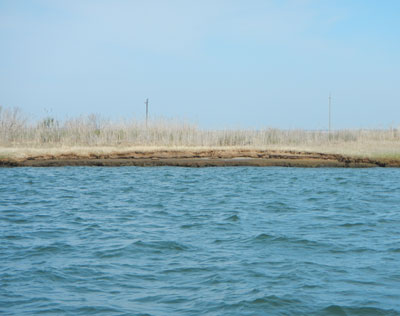Data Series 993
By Marci E. Marot, Christopher G. Smith, Alisha M. Ellis, and Cathryn J. Wheaton
| Abstract
 Photograph showing cliffing of the marsh surface along the western shore of Little Egg Harbor in May 2014. Photograph by Christopher G. Smith. [Click to enlarge]
Photograph showing cliffing of the marsh surface along the western shore of Little Egg Harbor in May 2014. Photograph by Christopher G. Smith. [Click to enlarge]Barnegat Bay, located along the eastern shore of New Jersey, was significantly impacted by Hurricane Sandy in October 2012. Scientists from the U.S. Geological Survey (USGS) developed a multidisciplinary study of sediment transport and hydrodynamics to understand the mechanisms that govern estuarine and wetland responses to storm forcing. This report details the physical and chemical characteristics of surficial and downcore sediments from two areas within the bay. Eleven sites were sampled in both the central portion of the bay near Barnegat Inlet and in the southern portion of the bay in Little Egg Harbor. Laboratory analyses include Be-7, Pb-210, bulk density, porosity, x-radiographs, and grain-size distribution. These data will serve as a critical baseline dataset for understanding the current sedimentological regime and can be applied to future storms for understanding estuarine and wetland evolution. This report serves as an archive for sedimentological and radiochemical data derived from the surface sediments and box cores. Downloadable data are available as Excel spreadsheets, PDF files, and JPEG files, and include sediment core data plots and x-radiographs, as well as physical-properties, grain-size, alpha-spectroscopy, and gamma-spectroscopy data. Federal Geographic Data Committee metadata are available for analytical datasets in the data downloads page of this report. AcknowledgmentsThe authors thank Rose Petrecca of Rutgers University Marine Field Station for logistical support, vessel operation, and facility use during field collection and core sampling. We also appreciated the Web design assistance provided by Noreen Buster and Jolene Gittens of the U.S. Geological Survey, and the laboratory assistance provided by Scott Adams with Cherokee Nations Technology Solutions. We also extend additional thanks to Noreen Buster and John Lisle, both of the USGS, for their pre-release commentary and peer review. Information StatementAlthough these data were processed successfully on a computer system at the U.S. Geological Survey (USGS), no warranty expressed or implied is made regarding the display or utility of the data on any other system, or for general or scientific purposes, nor shall the act of distribution imply any such warranty. The USGS or the U.S. Government shall not be held liable for improper or incorrect use of the data described and (or) contained herein. Any use of trade, firm, or product names is for descriptive purposes only and does not imply endorsement by the U.S. Government. Suggested CitationMarot, M.E., Smith, C.G., Ellis, A.M., and Wheaton, C.J., 2016, Evaluating the potential effects of hurricanes on long-term sediment accumulation in two micro-tidal sub-estuaries—Barnegat Bay and Little Egg Harbor, New Jersey, U.S.A.: U.S. Geological Survey Data Series 993, https://dx.doi.org/10.3133/ds993. ContactMarci E. Marot |